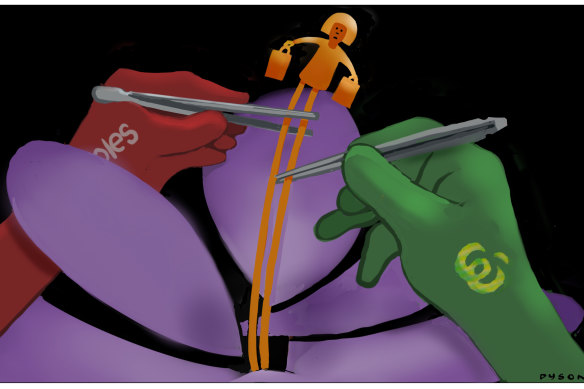This was published 1 year ago
Opinion
Are Coles and Woolies milking us? Check the price of saffron
Shane Wright
Senior economics correspondentWhen you think about pricey items in the supermarket, a cut of porterhouse, which usually goes for about $50 a kilogram, might be at the top of your list. However, the most expensive item in a supermarket is saffron.
Still processed manually, the dried stigma of the saffron crocus flower is incredibly delicate, difficult to harvest, and sells for between $59,500 and $144,400 a kilogram in Australia.

Australia has a supermarket duopoly.Credit: Andrew Dyson
In fact, the price of saffron offered by Coles and Woolworths is almost identical, which is to say, identically expensive.
In a nation like the United States, where there isn’t a supermarket duopoly, saffron is still expensive. But at $17,055 a kilogram, the difference in cost for an ingredient used in a good paella is mind-boggling.
This price difference also says a lot about how Australians are being done over by a grocery retail sector that offers high prices alongside wonky trolleys, aisles clogged with “personal shoppers” and checkouts increasingly devoid of actual humans.
Coles and Woolworths – which enjoy a combined control of about 70 per cent of the nation’s grocery market – have been attracting a lot of attention since announcing major profits for the just completed full year. Where Woolworths recorded an annual profit of $1.6 billion, Coles recorded $1.1 billion. These respective billions were in addition to the $48 billion of revenue Woolies recorded during the same period, to Coles’ $40 billion.
On their own, profits in excess of $1 billion seem large for any sector. But in the case of supermarkets, an important proviso is the total volume of sales needed to get those profits.
In a truly competitive market, where inflation is rampant (to such a point that both grocers are reporting an increase in theft) and consumers are taking a hammering, such sizeable profit improvements should not be occurring. Because if the supermarket chains were truly competing, there would be more downward pressure on their overall prices with things costing a lot less, not more. Instead, we see both Woolworths and Coles constantly bemoan that they “have” to pass on inflation to shoppers.
While they may not be deliberately driving up prices, they’re not going out of their way to engage in cut-throat competition that would reduce product prices. And that’s because the pair benefit from the side effects of inflation. Trying to save money amid the cost-of-living crisis, consumers are cooking at home more and increasingly buying home-brand products in favour of more expensive branded products.
If it wasn’t for the green livery of Woolies and the red of Coles (and their 1980s-heavy inhouse radio), it would be difficult to know the difference between the supermarkets these days.
From bananas to beef and canned tomatoes, they are all the same. There are differences when it comes to items on special, but when it comes to something beyond the deals rack, like saffron, the competition disappears.
Even on the rare occasion where the duopoly has genuinely competed, its consumers and producers have ended up on the losing side.
Coles famously began the “milk wars” of the 2010s, when it began selling the dairy staple for $1 a litre. Woolworths quickly followed suit. But guess what? A decade on, inflation has climbed by 17 per cent since then and yet, the price of milk has increased by 34 per cent.
In a properly competitive market, shoppers are offered a wide range of prices and product choices.
In the US, for example, Walmart (which controls about 25 per cent of the market), along with nine other grocery chains, account for 60 per cent of the American grocery market. In Britain, you need the five largest chains – Tesco, Sainsbury’s, Asda, Aldi and Morrisons – to achieve the market share that Woolies and Coles enjoy here.
This is an issue that goes to the heart of the grocery industry in this country. Everything from planning laws (of Costco’s 15 outlets in this country, three are at airports) to the way our shopping centres operate has conspired against shoppers while assisting the two major chains.
And it’s spread across the country, too. In the aviation, beer and ice-cream industries, we see duopolies. In banking, energy and telecommunication, we see oligopolies dominate. Private toll roads, meanwhile, are virtually a Transurban monopoly.
All this means that every time you want to feed your family, have a beer, enjoy a summer afternoon treat, fly somewhere, make a phone call, pay your mortgage, drive in a capital city or switch on a light, the competitive forces that could deliver you the best possible prices or choices are missing.
The one industry where this is changing, however, is in streaming. In addition to having the option of Stan, Netflix, Binge, Hulu, Apple TV, Disney Plus and the many other available options, streaming services also offer staggered pricing options. Netflix, for example, offers an ad-filled option at a bargain price, which means you can either move slowly through Sex Education to see what happens to Maeve and Otis, or pay extra to get an ad-free resolution. It’s your choice.
This is happening because as a new market with relatively low barriers of entry, streaming services recognise that price is a key area of competition.
Sadly, this is still not so in the Australian supermarket sector. Head into a shopping centre, turn left, and you’re at Woolies. Turn right and you’re at Coles.
Hard as you look, your grocery receipt won’t include the cost of living in a country with a supermarket duopoly.
Shane Wright is a senior economics correspondent.
The Opinion newsletter is a weekly wrap of views that will challenge, champion and inform your own. Sign up here.